I don’t know why i ended up with so many art projects in and about The Hague this year, but there you are, or here I am, really. It’s one of the most interesting places on Google’s green Earth.
Anywhay, Since i was as close as Amsterdam, i thought I’d take a little trip over to Den Haag and see some of the places I’ve been virtually obsessing over. It’s been awesome. Stay tuned.
Meanwhile, i can’t link too easily from this iPod, so if you don’t know what I’m talking about, check around the site for Walking Man and the Binnenhof, and of ourselves, Dutch Camo Landscapes.
‘Nylon Airhouses’ By Frank Lloyd Wright
I’m thinking I might have to change the name of this blog to Holy Smokes, but holy smokes, did the past ever look more futuristic than it did in the pages of LIFE Magazine, November 11th, 1957?
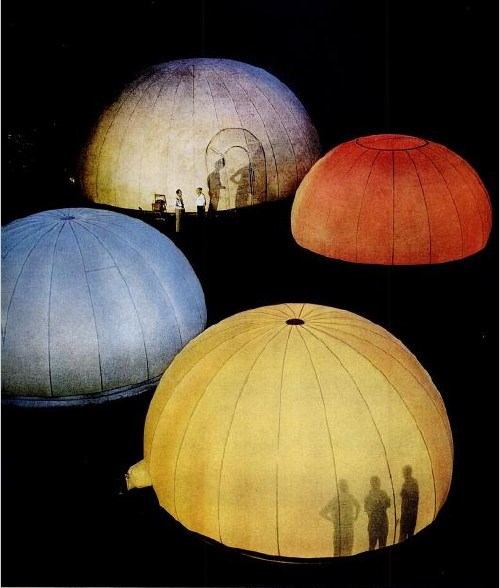
That’s where I found the house of the future of the past, Eduardo Catalona’s Raleigh House, in the issue titled, “Tomorrow’s Life Today – II.” There’s also THE Monsanto House of the Future from Disneyland. There’s an Alcoa aluminum beach cabana thing; the cover’s got a transparent, inflatable pool dome; a three-generation family of mimes, I guess, laying around in black leotards on a candy-colored assortment of foam slab furniture. And then there’s this:
Nylon Airhouses pop up on a university campus in Kentucky. Made of U.S. Rubber Company’s Fiberthin, a vinyl-covered nylon fabric four times as strong as waterproof canvas yet 40% lighter in weight, domelike houses are kept up by air, pumped in by small motors. They are anchored at base by a ballast ring of sand or water…
According to Sean Topham’s Blowup: Inflatable Art, Architecture & Design, this “Fiberthin Village” or “Rubber Village” of airhouses was designed by none other than Frank Lloyd Wright.
Actually, according to Billboard, US Rubber was manufacturing the warehouse-sized airhouses, but the domestic-scale models were being produced by the Irving Air Chute Company of–aha–Lexington, KY. Now that you mention it, they do look rather parachutish.
But why is Billboard reporting on repurposed military technology? Because in the summer of 1957, airhouses were competing against an international chain of “balloon bijoux” for the right to stage concerts in Central Park. What’s “most appealing” about these inflatable concert venues, we learn, is that they promised “the virtual elimination of large crews of roustabouts to set [them] up.”
In 1961, The Rotarian reported that, in addition to U.S. Rubber–which also introduced Keds, by the way, in 1917–a major player in the growing inflatable dome building industry was G.T. Schjeldahl, who also fabricated the Project Echo satelloons. See, it all comes back around.
Enzo Mari, Artist
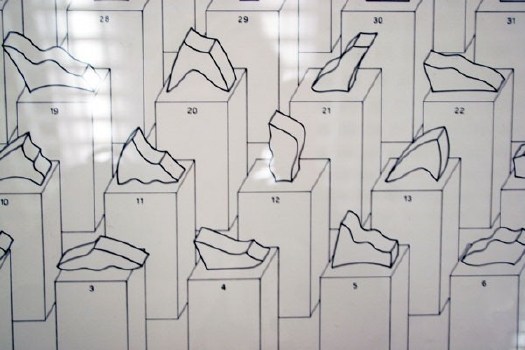
Look, I don’t doubt that Enzo Mari hates the art world as much as he hates design. Even more, probably, since he’s a faithful communist in an era when–Picasso bedamned–it’s really hard out there in the art market for a Red.
But.
Mari is just as resolute about not distinguishing between art and design. And he makes art. Objects. And has, for over 60 years.
Just check this out, 44 valutazioni, a suite of 44 abstract sculptures Mari exhibited at the 1976 Venice Biennale.
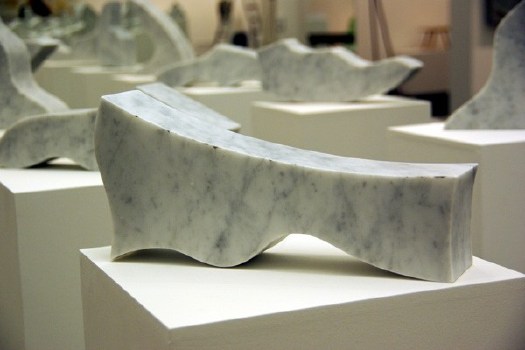
When they’re listed in order the title from each piece becomes the line in a poem by Francesco Leonetti, and when they’re assembled, well, hello, comrade! A hammer and sickle! Old school.
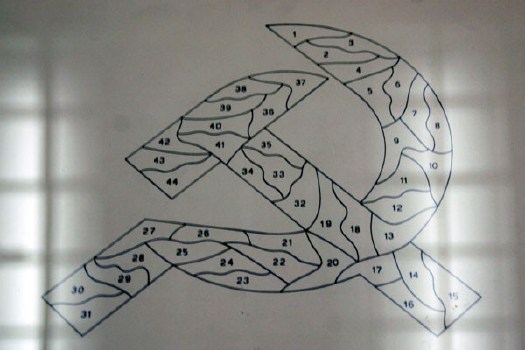
installation images of Mari’s GAM Torino show from designboom‘s extensive galleries.
We’ve brought Group ZERO back, right? At some point, the art world, and art history, are going to have to take Mari’s artworks into account, because, damn. He was doing minimalism and seriality a full decade before Judd and Lewitt.
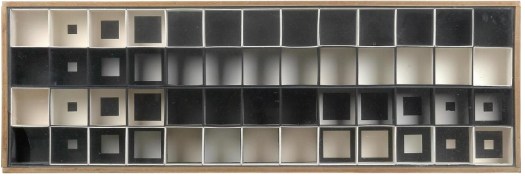
What are these struttura of which no one really seems to speak? [Except here, in a 30-year-old Italian monograph titled, naturally, Enzo Mari, Designer, which includes a chapter on Mari’s “research of form” and these “instruments of perception”?]
1956, struttura no. 301? Really? The only thing more eyebrow-raising than your date is your estimate: EUR6-8,000 at Dorotheum.
[OK, so maybe six years before Lewitt. Here’s his 1962 painting Objectivity at the National Gallery of Art:]
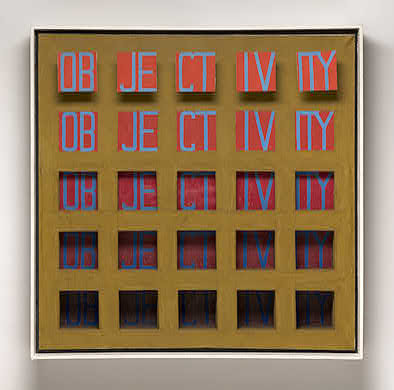
[I guess I was thinking of Lewitt’s 1967 Dwan Gallery show–and exhibition poster/print–and his 1968 photo object, Schematic Drawing for Muybridge, as seen here in flickr user clarkvr’s snap:]

But then there’s kinetic art, too. And what in the world is this? Omaggio a Fadat, 1967, a machine for “creating virtual volume” made from 64 lights, switches, steel, and perspex?
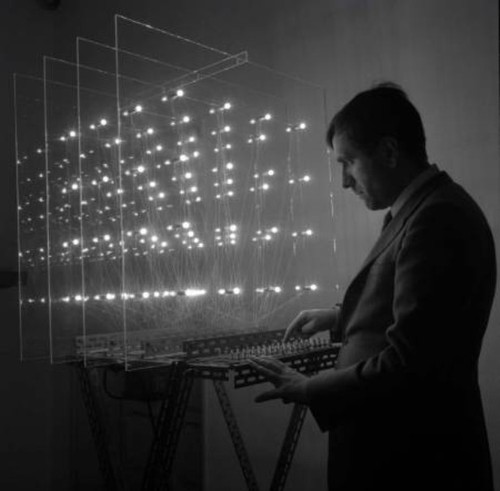
I mean, I know he had a show last year [2008-9, actually] at GAM Torino, but even if you call it “The Art of Design” and include a bunch of awesome sculptures, shoehorning 60 years of stuff into one gallery of a municipal museum is not exactly a retrospective. Look at this Omaggio, for example, if you can:
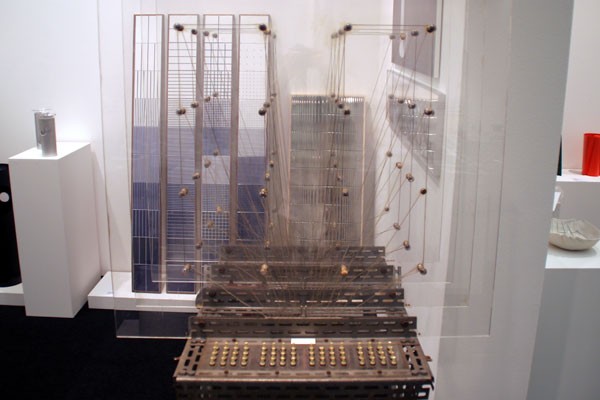
Also, he curated the show himself. Or designed it himself, using objects selected by his friends. Believe me, I know DIY’s his big thing, but seriously. It’s not like Mari’s an unknown quantity, and his influence is readily acknowledged–hell, he’s a huge influence on me, and building his autoprogettazione table as an art exercise, then devising an exhibition based on his principles of authorized reproducibility have kept him on the top of my mind for much of the last four years, at least–but he seems relegated to the designer’s corner, and his artwork–oh how sweet, the designer makes art, too!–with him.
Or am I missing something? Please say yes. [hmm, after some market-related digging, Mari’s problem may be that he makes Italian art, and only two Italian artists are allowed to become well-known outside of Italy each decade. Not much to be done about that, I guess.]
Eduardo Catalano’s Raleigh House
I couldn’t really articulate it at the time, but the overwhelming absence of modernist architecture was an integral part of growing up in Raleigh, North Carolina. The country roads were widened, and winding capillaries and cul de sacs were cut into the pine forests on either side, which were given ever more oblique English-sounding names, and whose lots were promptly filled with tens of thousands of Colonial Williamsburg knockoffs.
But I did date a girl in high school who lived in an early 70s, wood-clad, contemporary-style house. It was just off of Ridge Road.
Just off of Ridge Road was also where the Argentine-by-way-of-Harvard architect Eduardo Catalano designed himself a house in 1954, when he came to teach at the just-founded School of Design at NC State. How did I never go to this house?
Catalano’s house was an 1800 square foot glass box underneath an absolutely stunning 3600-sf hyperbolic paraboloid roof which, holy crap. It’s, well for one thing, it was Wolfpack Red.
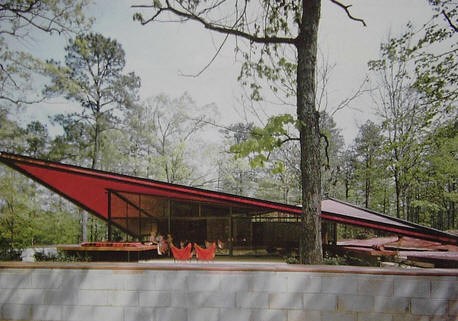
LIFE Magazine called it the “Batwing House” in 1957, and noted that “the shape makes it possible to have a thin roof with great structural strength [apparently, thin meant just 2.5 inches. ed.]. It is supported on the ground at only two points. Catalano is now trying to arrange mass production of its roof in aluminum instead of costly laminated wood strips.”
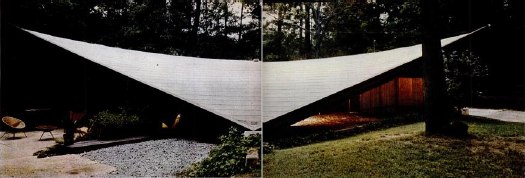
Aluminum? How about poured concrete? That’s what Le Corbusier and Iannis Xenakis built the striking paraboloid peaks and folds of the Philips Pavilion out of at the 1958 World Expo in Brussels. How quaint of Brussels and Corbu, to be only 3-4 years behind the architectural innovations of Raleigh, North Carolina.
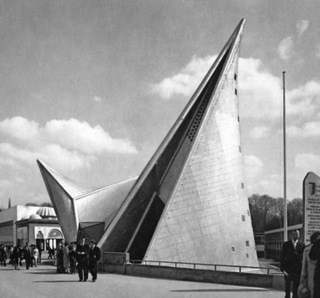

But Williamsburg will out. Catalano left for Boston in 1956 and sold what he always called the “Raleigh House” to some locals. Who sold it to some people who rented it. Who sold it to a guy who asked Karl Gaskins, the architect who, it turns out, designed my HS friend’s house, to design an addition, which was never realized. And who abandoned it behind chainlink fencing for six years so it could rot. That was from 1996 to 2001, exactly the miniscule window of time when the last vestiges of my intention to move back to North Carolina “someday” overlapped with my own dotcom bubble. When no saviors could be found, the house was razed and the lot divided for two McMansions in 2002.
And Catalano spent the last eight years of his life trying to have his Raleigh House roof, at least, re-created, maybe at the NC State Museum of Art? At the garden of his former school, NCSU? At the former, he was politely rebuffed. At the latter, he faced a surprisingly vocal opposition from professors in the landscape design department.
To these pine tree-pushing philistines, I say, “Whatever.” And I will add Catalano’s house to the list of Things I Want To See, And So Must Rebuild.
Triangle Modernist Houses has the whole happy/sad tale of Catalano’s masterpiece, and a bunch of photos [trianglemodernisthouses.com now usmodernist.org]
Half-Keynesian
This is pretty damn funny. I heard somewhere that it’s unconstitutional for a president to be even half-Keynesian. I think it was Fox Business. [via andrewsullivan]
Now That’s A Headline
So much to do, so tempted to lose myself in Civil War-era New York Times archives. Taken from his diaries which later became Memoranda During The War, Walt Whitman’s report on December 11, 1864 is incredible, but the headline itself is like poetry of another kind:
OUR WOUNDED AND SICK SOLDIERS.; VISITS AMONG ARMY HOSPITALS, At Washington, on the Field, and here in New-York. CAMP HOSPITALS, FREDERICKSBURGH, NEAR FALMOUTH, VA. VIA AQUIA CREEK, UP THE POTOMAC. SPECIMENS OF HOSPITAL VISITS. FIFTY HOURS LEFT WOUNDED ON THE FIELD. METHOD OF VISITS, ENLIVENING, ETC. WRITING LETTERS BY THE BEDSIDE. AFTER CHANCELLORSVILLE. JUNE, JULY, ETC. THE HOSPITALS FULL. AMBULANCE PROCESSION. DEATH OF A NEW-YORK SOLDIER. VISITS CONTINUED HOSPITAL WISDOM. CULPEPPER AND BRANDY STATION. MARCH AND APRIL, 1864. AROUND WASHINGTON. WOUNDED FROM WILDERNESS, SPOTTSYLVANIA, ETC. LAMENTABLE DEFICIENCIES AFTER HEAVY BATTLES ASSISTANCE MORE ABOUT HOSPITAL VISITING AS AN ART. ICE-CREAM TREAT. CHARACTERISTIC SCENE IN A WARD. DEATH OF A CASE FROM SECOND BULL RUN. CONVALESCENT CAMP. LATTER PART OF 1864 IN NEW-YORK. READING, INTERESTING THE MEN, ETC. WOMEN NURSES. GOVERNMENT CARE FOR WOUNDED. LITTLE GIFTS OF MONEY. WOUNDS AND DISEASES. SURGEONS, THE YOUNG MEN. AMOUNT OF THE TWO YEARS’ VISITS. HUMAN MAGNETISM AS A MEDICAL AGENT. CONCLUSION
The Wound Dresser, Set In Stone
I’m feeling more serious about turning Richard Neutra’s Cyclorama building at Gettysburg into an educational monument to the wounded and a wheelchair-accessible battlefield observation platform.
War becomes history, reduced to its most basic contours, a date, a bodycount, and a winner:
Future years will never know the seething hell and the black infernal background of countless minor scenes and interiors, (not the few great battles) of the Secession War; and it is best they should not. In the mushy influences of current times the fervid atmosphere and typical events of those years are in danger of being totally forgotten.
…
The present Memoranda may furnish a few stray glimpses into that life, and into those lurid interiors of the period, never to be fully convey’d to the future. For that purpose, and for what goes along with it, the Hospital part of the drama from ’61 to ’65, deserves indeed to be recorded–(I but suggest it.) Of that many-threaded drama, with its sudden and strange surprises, its confounding of prophecies, its moments of despair, the dread of foreign interference, the interminable campaigns, the bloody battles, the mighty and cumbrous and green armies, the drafts and bounties–the immense money expenditure, like a heavy pouring constant rain–with, over the whole land, the last three years of the struggle, an unending, universal mourning-wail of women, parents, orphans–the marrow of the tragedy concentrated in those Hospitals–(it seem’d sometimes as if the whole interest of the land, North and South, was one vast central Hospital, and all the rest of the affair but flanges)–those forming the Untold and Unwritten History of the War–infinitely greater (like Life’s) than the few scraps and distortions that are ever told or written. Think how much, and of importance, will be–how much, civic and military, has already been–buried in the grave, in eternal darkness !……. But to my Memoranda.
That’s Walt Whitman’s foreword to his Memoranda During the War, a compilation of his diary entries, which he published in 1875.
In a country at war, so seemingly polarized by political disagreements, it’s odd how easy it is to forget that not only was there a civil war, there was an aftermath, where millions of Americans had to put their lives, their families, their cities, and their country back together again. Is forget the right word for something you presumably knew, or should have known, but really never gave a thought to?
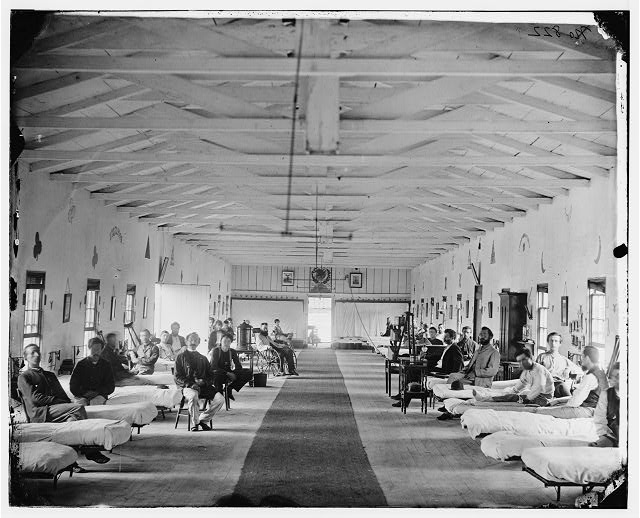
Armory Square Hospital, 1865, via loc.gov
Because I didn’t forget so much as never realized, never put it all together, that the wartime hospitals, where I knew Walt Whitman attended to wounded and dying soldiers, were not in Brooklyn, where the Whitman in my mind lives. They were in Washington, DC, where he’d come looking for his brother George, who’d been wounded in the battle of Fredericksburg. He stayed on, and tended over 80,000 men who belonged to what he called, “The Great Army of the Sick”:
June 25, (Thursday, Sundown).–As I sit writing this paragraph I see a train of about thirty huge four-horse wagons, used as ambulances, fill’d with wounded, passing up Fourteenth street, on their way, probably, to Columbian, Carver, and Mount Pleasant Hospitals. This is the way the men come in now, seldom in small numbers, but almost always in these long, sad processions.
Whitman also visited the hospitals at the Patent Office [now the Smithsonian Museum of American Art] and at Armory Square [above, now the site of the National Air & Space Museum]. His compiled letters to his mother, published in 1897 under the title of an 1863 poem, The Wound Dresser, contain additional details of his experience.
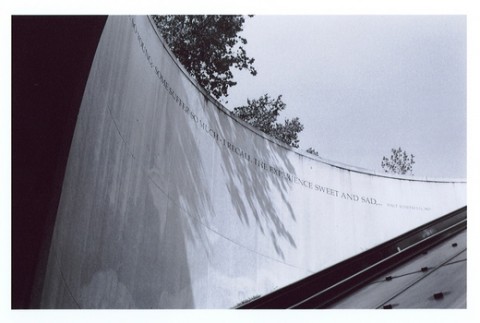
awesome torqued circle image by marc nielsen via flickr
Originally published as “The Dresser,” the poem is the centerpiece of Drum Taps, Whitman’s collection of war-related poems first published in 1865, and included in subsequent editions of Leaves of Grass, beginning in 1867.
A stanza of “The Wound Dresser,” or at least part of one, wraps around the cylindrical granite wall of the entrance to the DuPont Circle metro station:
Thus in silence in dreams’ projections,
Returning, resuming, I thread my way through the hospitals;
The hurt and wounded I pacify with soothing hand,
I sit by the restless all dark night – some are so young;
Some suffer so much – I recall the experience sweet and sad…
– Walt Whitman, 1867
New York carpetbagger and infrequent DuPont metro traveler that I am, I’d always assumed it was installed in the early 90s, an oblique sop of acknowledgment of the AIDS crisis. Ahh, yes and no.
The idea for the poems did originate with a community request to “honor those who cared for people with HIV/AIDS,” [2025 update: internet archive link] but this had been expanded to include caregivers for all kinds of illnesses. And so the D.C. Commission on the Arts and Humanities sponsored a competition for poems as part of the Metro’s Art in Transit program. In 2007.
One would think that a 150-year-old poem by America’s greatest poet could survive a seemingly routine governmental agency arts collaboration unscathed. But I guess the public art doctors felt they must amputate to save the patient. With the last two stanzas cut off the inscription serves as an inadvertent memorial to what must still be sacrificed to make a permanent mark on the official landscape of 21st century Washington:
(Many a soldier’s loving arms about this neck have crossed and rested,
Many a soldier’s kiss dwells on these bearded lips.)
For much, much original Whitman material and even more Whitman scholarship, visit The Whitman Archive [whitmanarchive.org]
Next, related: Toward a Cyclorama-shaped Gettysburg Memorial to The Wounded
William Lamson At Pierogi Boiler
“…how, slowly and patiently, Mr. Lamson, wearing welder’s goggles, moves his drawing machine along.”
William Lamson‘s show at The Boiler, “A Line Describing The Sun,” got a nice review from Ken Johnson in the Times today.
The 2-channel video of the making of is pretty awesome.
Art Is Where You See It: YouTube Play @Guggenheim
Though I had considered entering, and I’d sampled a few of the 125 videos on the shortlist, I had planned to not write about the YouTube Play Biennial at the Guggenheim. But then reps from a couple of the event’s sponsors, HP and Intel, asked if I’d guest post about art, video art, and film in their Facebook group, 24|7 Creative, and they invited me to attend the big gig at the Gugg last week. Here is a brief recap of that experience, and how I see it.
[Holy smokes, this is long now, really, unbelievably long. And with a tragicomic surprise ending, too!]
Continue reading “Art Is Where You See It: YouTube Play @Guggenheim”
999 Mylar Balloons
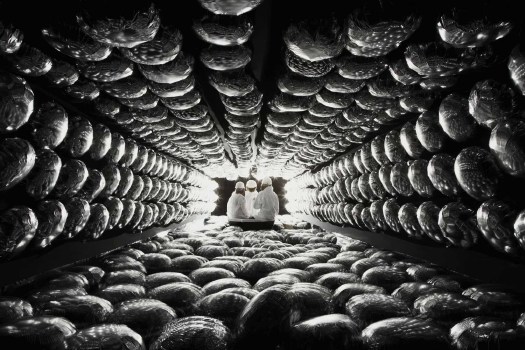
Holy smokes, experiential science artist Nelly Ben Hayoun has re-created Japan’s Super Kamiokande neutrino detection facility as a Disneyland ride.
Visitors in white Tyvek bunny suits are guided by an actual particle physicist through a boat ride tunnel where a thousand gold mylar balloons–birthday party size–stand in for the hand-blown glass photomultiplier tubes of the original.
It’s all going down this very minute at the Manchester Science Festival. Tomorrow’s the last day. And all but ten of us have already missed physicist/glassblower Jochen Holz‘s workshop over the weekend, where we would have made our own PMT! The photographer’s name is Nick Ballon!
Holy crap, English people! Why are you keeping all this stuff secret? Need the info!
Super K Sonic Booooum [superksonic.com via popsci, thanks john]
Shockingly closely related: The Hamamatsu Photonics R1449 And R3600 Photomultiplier Tubes: the making of [greg.org]
There’s One! Irving Blum’s Pasadena Type Brillo Box
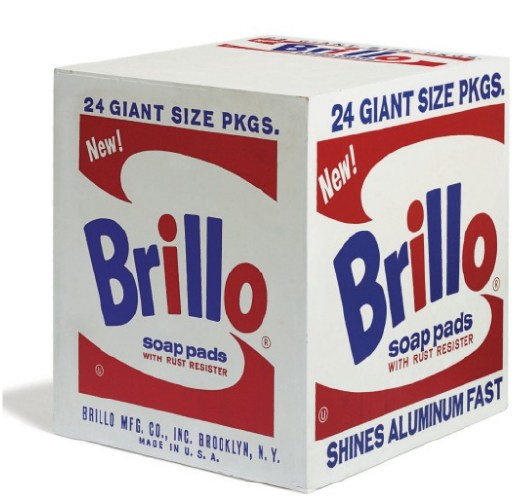
The close follower of the Warhol Brillo Box saga will surely find amusement in the details of Lot 137: a Pasadena Type box that once belonged to Warhol’s early early LA dealer Irving Blum at Christie’s upcoming Morning After sale.
You know, things like the date [“Executed in 1964-1969.”] and the provenance [“Irving Blum, acquired from the artist”].
Which, like the so-called Oberlin Boxes John Coplans got from Warhol for curating his first museum show, was one of the 16 or so extras made when Warhol authorized Coplans to fabricate 100 for his Pasadena Art Museum show in 1970.
Nov. 11, Lot 137: Pasadena Type Brillo Box, est. $350-450,000 [christies.com]
Black & White
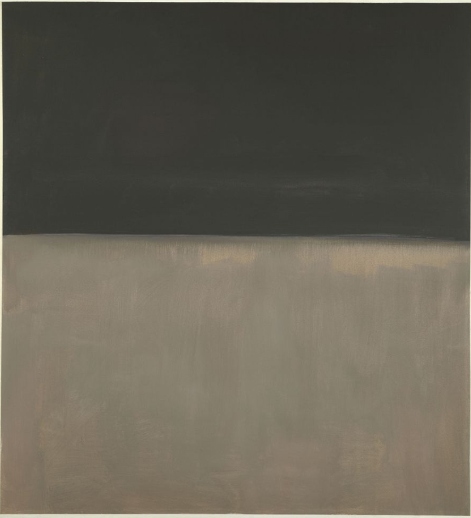
Holy smokes, the auction’s normal size, but the catalogue for Christie’s upcoming contemporary evening sale is huge. And some interesting stuff.
This late Rothko, Black on Gray (1969-70), for example. In his biography of the artist, Jimmy Breslin referred to this painting while saying that the series sometimes resembled “a stark lunar landscape.”

Frankly, it reminds me of a favorite, stark lunar landscape photo, an early Liz Deschenes work made in Death Valley in 1999: 280 Feet Below Sea Level. A copy of which happens to be coming up at auction soon after. With my luck, the underbidders on the Rothko are going to swoop in and bid the price way up.
Nov. 10, Lot 28: Mark Rothko, Black on Gray, est. $10 million – 15 million [christies.com]
Nov. 13, Lot 661: Liz Deschenes, 80 Feet Below Sea Level, est. $2500-3500 [ragoarts.com]
Ansel Adams’ Japanese American Internment Camp Photos At MoMA. Shhh!
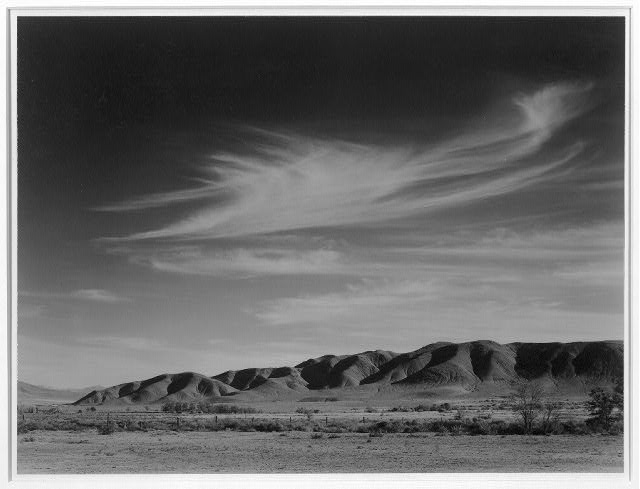
Someday this will all look and sound really coherent, I swear. But for going on, wow, 20 years, some of the most powerfully influential photos for me have been the images Ansel Adams took at Manzanar, the desert prison camp where Japanese-American families were interned at the outset of WWII. Deeply outraged that the US government would imprison its own citizens en masse, Adams set off to document the situation in 1943. In late 1944, he published a book, Born Free and Equal, which contained his text and a selection of the photos.
I spent years chasing down a copy of the book. And collecting prints from the series. And working with the Museum. And yet it was somehow only last week that I found out that in November 1944, Adams’ Manzanar photos were exhibited at the Museum of Modern Art.

Given that Adams had been asked by Edward Steichen to join his elite Naval Aviation Photography Unit, and that Adams was close with the Modern’s photography curator Beaumont Newhall and his wife, one might think that Adams’ wartime photos would have received the same prominent promotion and large-scale exhibition printing that Steichen’s Power in the Pacific show received a couple of months later.
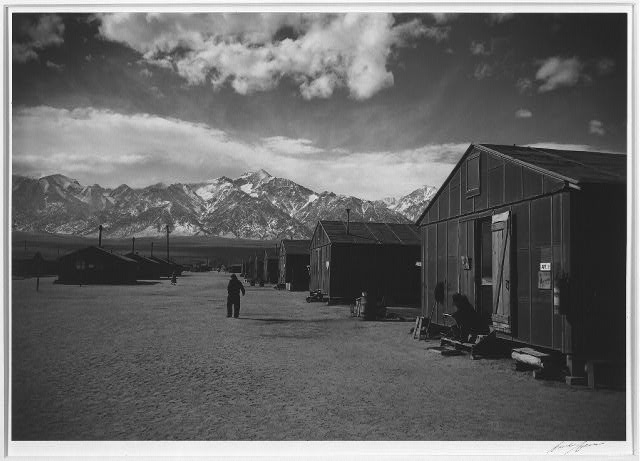
And one would be deeply and completely wrong. According to the most tepid press release in the Museum’s history,
A series of sixty-one photographs showing the life and activities at a relocation center in California form an exhibition opening in the auditorium galleries of the Museum of Modren Art Friday, November 10, under the title Manzanar: Photographs by Ansel Adams of Loyal Japanese-American Relocation Center. Mr. Adams has also written the accompanying text. The exhibition, an unusual demonstration of the use of documentary photography, will be on view through December 3.
The exhibition is described as “an activity of the Museum’s Photography Department,” and its acting curator, Nancy Newhall. Pull every string he has at the Museum, and still the best Ansel Adams can do is a three-week show in the basement.
Ansel Adams donated his Manzanar photos to the Library of Congress [loc.gov]
Previously: I Mean, Just Look How Happy They Were! [greg.org]
Observations On/From Towers
Last May, while solving the problem of Gettysburg and reuniting the opposing forces of History–Civil War battlefield aficionados seeking to “restore” the “hallowed ground” of Cemetery Ridge and the modernists and historical preservationists who wish to stop them from demolishing Richard Neutra’s Cyclorama building–I myself was smitten by the archival/architectural awesomeness of the steel observation tower [below], which was built by the War Department in 1895 on the [equally hallowed, I’m sure] Confederate line.
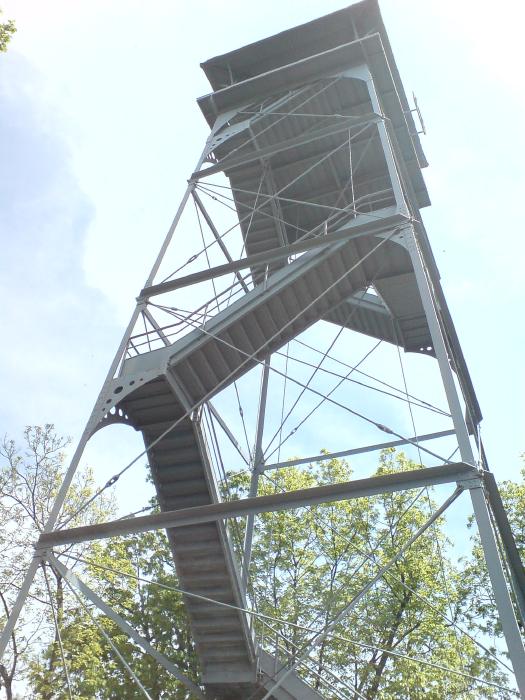
[My idea, of course, is to adapt Neutra’s ramp-centered structure into a disabled/wheelchair-accessible observation platform, an accommodation which is sorely lacking in the current Park Service program for the site, and then to integrate a museum/memorial to the tens of thousands of soldiers wounded–and disabled–in the battle. We’re so quick to memorialize those who were lost, while forgetting or ignoring those who survived, and have to grapple for the rest of their lives with the effects of war.]
Anyway, two added pieces of information:
While I have not been able to find much in the way of history or documentation for the 1895 towers [there used to be five; now there are 2.5], I have discovered two accounts of a re-enactment of Pickett’s Charge in July 1922, on the occasion of the 59th anniversary of the battle. On July 2 President Warren G. Harding and his wife observed a rehearsal re-enactment by 5,000 marines and veterans from an observation tower [since removed] on Cemetery Ridge itself.
[Bonus architectural note: The President and Mrs. Harding were quartered at the Marine camp in what the New York Times called, “a temporary White House of canvas and wood. The structure is equipped with elaborately fitted sleeping rooms, baths, electric lights and even has a front porch.” A search for photos has already begun. update: and may be over. Is this it, from the LOC?]
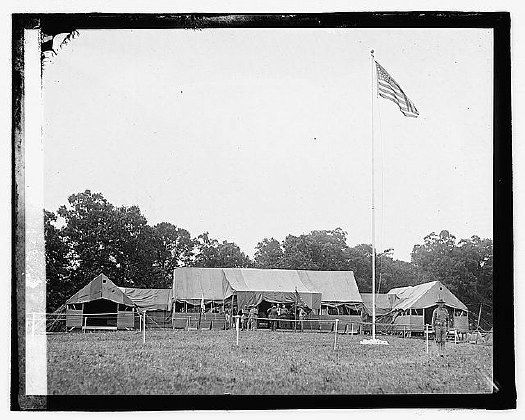
Another account, dated July 4th, after the Hardings had departed, comes from Mrs Helen Longstreet, the widow of the Commander of the Confederate forces at Gettysburg. It’s not clear, but I like to imagine that she observed the re-enactment–“staged today with marvelous accuracy in every detail, exactly as I have heard General Longstreet describe it hundreds of times”–from the still-extant observation tower on the field:
As the twilight of this calm July day deepened into dusk I overtook one of “Longstreet’s boys,” a one-armed veteran, trudging wearily “up Emmitsburg Road.”
“Where did you lose your arm?” I inquired. He answered: “In Pickett’s charge; and it was powerful hard to lose my arm and be whipped, too; and what was the use of it?”
Someone standing near pointed to the Observation Tower and said: “Do you see the flag that floats up there? The stars on its blue field are all the brighter, its red stripe all the deeper, its white stripe all the purer, because you left an arm in front of Cemetery Hill in Pickett’s charge. That was the use of it. That was the good of it.”
And so the tread of marching armies and the roar of cannon over the Summer lands of Pennsylvania call the American people to express the value of the titanic struggles of the ’60s in deeper love and pride of country.
And the other thing, holy moley, have you seen the observation tower built by the Graz/Munich-based landscape design firm Terrain in a nature preserve along the Mur River in Styria, Austria?? 27.5 meters high, double rectangular spiral of black steel and tension rods, plus aluminum staircases.
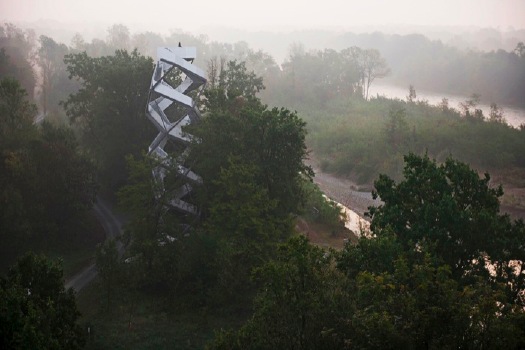
Not that I thought anyone might be wavering on the architectural merits of observation towers or anything, just, wow.
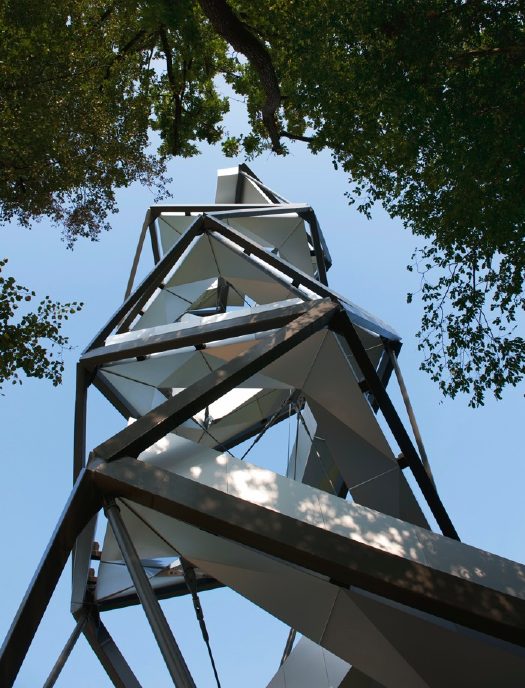
[images: just two of many at Abitare]
Related: Photomurals In Stardust Memories By Woody Allen [Not Related]
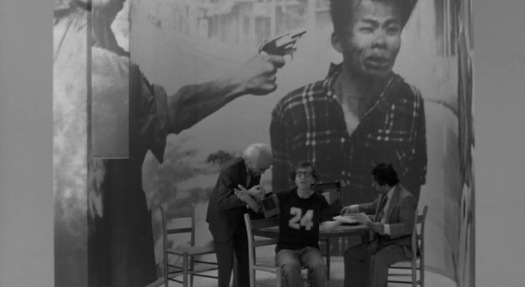
My recent photomural binge has flushed out some interesting comments and suggestions, including one from Craig about the use of a photomural as a key interior design element in Woody Allen’s 1980 film, Stardust Memories.
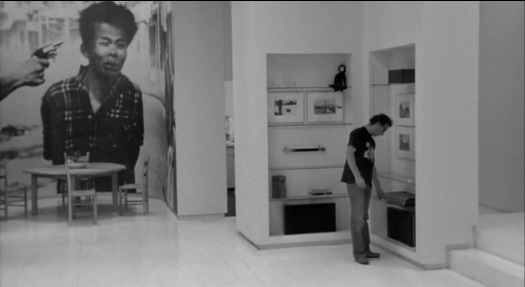
Allen’s character, filmmaker Sandy Bates, has wrapped the dining room of his Manhattan apartment with a photomural of Eddie Adams’s iconic 1968 AP photo from the Tet Offensive of the shooting of captured VC Nguyen Van Lem by South Vietnamese General Nguyen Ngoc Loan. [above] It was commonly understood to be a universal symbol of man’s cruelty, suffering, and inevitable mortality.
The shocking juxtaposition hadn’t worn off for Richard Woodward, who used the fleeting scene a full nine years later as the opening anecdote for a critique of art’s changing relationship with documentary photography. Titled, with the cloying question mark, “Serving up the Poor as Exotic Fare for Voyeurs?” Woodward seems to complain that the art world, which “favors big pictures and high prices” was messing it up for real [aka “documentary”] photography and serious subject matter:
Perhaps nothing in the film better conveys the twisted soul of the protagonist who, in his misguided need to project, magnify and expiate his guilt over the world’s pain, has turned a moment of unforgettable horror into a decorative mural. It’s a macabre joke about the heartless vanity that can underlie high-minded gestures; and it’s a warning about photography, which can lose any claim as a moral force after countless reproductions on the wrong kind of wall.
But then he ended with this:
Many contemporary artists, like Alfredo Jaar, Sarah Charlesworth and Louise Lawler, are making work in which the use of an image – its presentation by the news media or a museum – becomes the grounds for critical scrutiny in a context of the artist’s own devising. A persistent theme of art in the late 80’s has been the struggle to patrol and examine the use of images. At the very least, many artists seem to be saying, it is time to stop averting our eyes.
Only this turns out to be exactly what Woody Allen was doing a full decade earlier.
Whether it’s Supergraphics or Stephen Shore’s Architectural Paintings or a Bloomingdale’s furniture showroom, there has to be some context or precedent I’m missing here, otherwise Woody Allen should be figuring directly into the history of the emergence of the Pictures Generation.
Because the heavily stylized, black & white Stardust Memories turns out to use photomurals and their relatives as crucial thematic and visual elements.
First off, Allen has said that most of the film actually takes place in his character’s head. Even his apartment, which is nominally in the film’s reality, “is really a state of mind for him. And so depending on what phase of life he’s in, you can see it reflected in the mural.”
Though Adams’s photo is often mentioned, and the stills above are common, I couldn’t find images of any of the other murals. So I just rewatched Stardust Memories [at high speed] and pulled out all the ones I could find. I’d hoped that I could find some discussion of the murals and the film’s design from production designer Mel Bourne, but so far, nothing. Bourne did several films with Allen, including Annie Hall and Manhattan, But he also did the production design for Fatal Attraction and, awesomely, the pilot for Miami Vice. Anyway, they’re all after the jump, because, maybe some people might want to skip them? Not me.
Continue reading “Related: Photomurals In Stardust Memories By Woody Allen [Not Related]”
